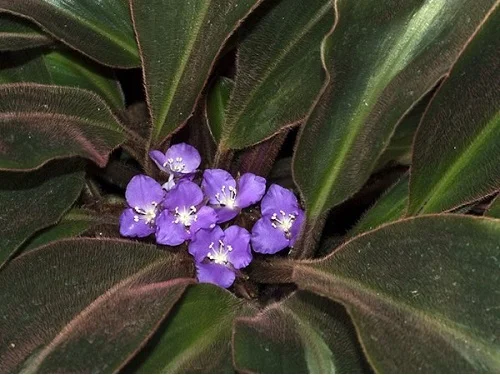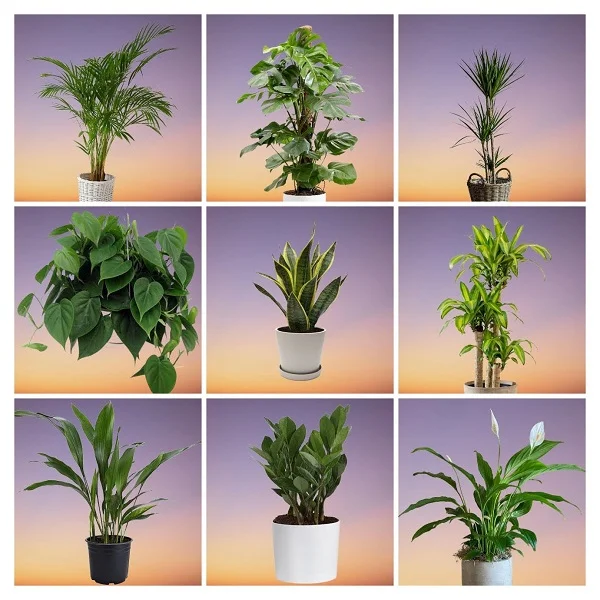Brown Spiderwort (Siderasis fuscata) Indoor Care, Propagation, Problems and Remedies
Some links in this post may be affiliate links
Brown Spiderwort (Siderasis fuscata) thrives in medium indirect light, warm and humid conditions and moderately moist, rich, well-drained soil coupled with monthly feeding in the growing season.
Siderasis fuscata also called Bear Ears Plant is a beatutiful, small indoor plant with a rosette of short, bronze-colored leaves which gives this plant its common name, 'Brown Spiderwort'.
Brown Spiderwort can grow to a height of 1-1.5 feet and the leaves are only about 6-8 inches long. It bears attractive purple flowers about 1 inch across if the correct growing conditions are provided.
Siderasis fuscata exhibits some characteristics similar to those of Tradescantia plants and was intially classified under Tradescantia genus and hence the synonym Tradescantia fuscata.
On account of its compact size and requirement for warm humid conditions, Brown Spiderwort is one of the best plants for a closed terrarium where these conditions are present.

Botanical name: Siderasis fuscata
Synonmy: Tradescantia fuscata
Family: Commelinaceae
Subfamily: Commelinoideae
Common name: Brown Spiderwort, Bear Ears Plant
Origin
Siderasis fuscata is endemic to the State of Rio de Janeiro in Southeastern Brazil, though it is also naturalized on the Island of Java in Indonesia.
Is Brown Spiderwort poisonous?
No. Brown Spiderwort is non-toxic to humans and pets. Siderasis fuscata are safe for cats, dogs and other pets making it perfect for a home with pets.
How do you care for Brown Spiderwort indoors
To care for Brown Spiderwort indoors, provide medium indirect light, average warmth of 18-270C, humidity of 70-80% and moderately moist, fertile, well-drained soil coupled with monthly feeding during the growing season.
Siderasis fuscata care also requires pruning to keep the plant neat and to reduce pest and disease infestations. Repotting is only needed when the plant has become pot-bound. Keep reading for more on these growing conditions and how to achieve them.

Light Requirements
Does Brown Spiderwort like shade or sun?
Brown Spiderwort grows best in medium indirect light. Put it near a large, bright window. Keep it away from direct sunshine as it can lead to scorching of the leaves.
Too little light will result in loss of leaf color and leggy growth. Therefore, where the natural light is not sufficient, use a full spectrum grow light to supplement it.
Turn the pot regularly to ensure that the plant receives light on all sides for uniform growth and to prevent legginess.
Watering
How often do you water Brown Spiderwort?
Water your Brown Spiderwort liberally in spring and summer while allowing the top 2-3 inches of soil to dry out between waterings. Keep the soil moderately moist and avoid overwatering to prevent yellowing and rotting.
Decrease watering in fall and winter to maintain the soil slightly moist as growth is minimal at this time. Do not allow the soil to dry out completely to avoid getting wilting, shrivelling leaves.
Use water that is at room temperature as too cold water can cause reduced growth and death of the plant. To prevent brown leaf tips use chlorine-free water like rain water or filtered water.
Ascertain the pot has a drainage hole to prevent the soil from getting soggy as it may lead to root-rot and loss of the plant.
Temperature and Humidity
Siderasis fuscata flourishes in average warmth of 18-270C; a room temperature that is comfortable for you is ideal for this plant. Keep it away from drafts to prevent sudden changes in temperature as they can cause reduced growth and leaf drop.
Brown Spiderwort prefers a high humidity of 70-80%. Set the pot on a wet pebble tray or use a humidifier to raise humidity as too low humidity may result in brown leaf tips and edges. Ensure that there is good air circulation to minimize fungal diseases.
You may also grow the plant in a closed terrarium as a high humidity can be maintained inside a terrarium. In addition, it can be grown in a well-lit bathroom and other moist areas in the home.
Fertilizer
Feed your Brown Spiderwort with a balanced, liquid fertilizer every 3-4 weeks in spring and summer for lush growth. Do not feed in fall and winter as growth is minimal and feeding at this time may lead to fertilizer burn and death of the plant.
Occasionally, leach out accumulated salts by running a stream of water through the soil until it comes out through the drainage hole.
Potting Soil
The best soil for Brown Spiderwort should be rich in organic matter and free-draining to prevent waterlogging while providing the required nutrients.
Repotting
Repot Brown Spiderwort during the growing season only when the plant has become pot-bound. Use a rich, free-draining soil and a pot one size larger than the current one.
Make sure that the pot has a drainage hole to prevent the soil from getting soggy as it can lead to root-rot. Take a look at these pots with drainage holes on Amazon.
Pruning & Grooming
Pruning Brown Spiderwort involves regular removal of dead foliage to maintain the plant neat and also reduce pest and disease infestations.
Regularly clean the leaves by damp-wiping with a soft cloth to get rid of dust as well as reduce infestation by pests.
Siderasis fuscata Propagation
Brown Spiderwort (Siderasis fuscata) propagation can be done by plant division during the growing period.
Propagating Brown Spiderwort by plant division
- Thoroughly, water the plant at least one day before to hasten rooting and establishment.
- Slip the plant from its pot and carefully divide it into several sections. Ensure each section has adequate roots and at least one set of leaves.
- Pot the sections in individual pots in free-draining soil.
- Place the set up in a warm, well-lit place away from direct sunlight to avoid scorching.
- Maintain the soil moist through until new growth emerges on the sections.
- Allow the new plants to be well established before transplanting after which you can begin routine care.

Siderasis fuscata Problems & Solutions
Brown Spiderwort (Siderasis fuscata) problems are brown leaf tips, plant dying, brown leaves, plant falling over, yellow and spotted leaves, loss of leaf color, and pests. Read on for more on these problems, their remedies and solutions.
Brown leaf tips
Why are the tips of my Brown Spiderwort leaves turning brown?
The tips of your Brown Spiderwort leaves are turning brown due to low humidity, salts buildup, and use of hard water.
How to fix it
Low humidity: To increase humidity, set the pot on a wet pebble tray, use a humidifier or grow the plant in a well-lit bathroom, kitchen, laundry area and other moist areas in the home.
Salts buildup: Regularly flush out accumulated salts from the soil by running a stream of water through the soil until it drains through the drainage hole.
Use of hard water: Use chlorine-free water like rain water or filtered water.
Plant dying
Why is my Brown Spiderwort plant dying?
Your Brown Spiderwort plant is dying due to root-rot disease which is enhanced by soggy soil. It is characterized by yellowing and wilting leaves, rapidly followed by browning and plant collapse.
How do you revive Brown Spiderwort?
- Carefully slip the plant out of its pot and inspect the roots.
- Trim the brown-black, mushy roots and treat the healthy roots with a copper-based fungicidal solution as recommended by the manufacturer.
- Disinfect the pot with the fungicidal solution or use a fresh pot to repot the plant in fresh, well-draining soil.
- Do not water the plant immediately and keep it dry for 5-7 days before you can resume watering.
- Use a pot with a drainage hole and well-draining soil to prevent the soil from getting soggy.
- Cut down on watering in fall and winter as growth is slowed at this time; keep the soil slightly moist.
Brown leaves
Why is my Brown Spiderwort turning brown?
The main causes of brown leaves on your Brown Spiderwort are inconsistent watering, soggy soil, temperature stress, and direct sunlight.
How to fix it
Inconsistent watering: Do not water on a schedule. Water when the top 2-3 inches dry out. Never allow the soil to dry out completely.
Soggy soil: Use a pot with a drainage hole and well-draining soil.
Temperature stress: Keep the plant away from drafts coming from AC units, drafty windows, heat sources, windy doors and others.
Direct sunlight: Keep the plant away from direct sunlight or use a light curtain to filter the sunshine.
Plant falling over
Why is my Brown Spiderwort falling over?
Your Brown Spiderwort is falling over due to too little light, nutrients deficiency, overwatering, and soggy soil.
How to fix it
Too little light: Move the plant to a brighter spot or use a grow light if the natural light is not enough.
Nutrients deficiency: Feed the plant with a balanced, water-soluble fertilizer every 3-4 weeks in spring and summer.
Overwatering: Water only when the top 2-3 inches of soil feel dry to the touch.
Soggy soil: Pot the plant in well-draining soil and a pot that has a drainage hole.
Yellow and spotted leaves
Yellow and spotted leaves on Brown Spiderwort are caused by inconsistent watering, soggy soil and drafts.
How to fix it
Inconsistent watering: Water the plant when the top 2-3 inches of soil to dry out slightly; do not allow the soil to dry out completely.
Soggy soil: Use a pot with a drainage hole and well-draining soil.
Drafts: Keep the plant away from drafts from AC units, hot air vents, windy doors, hot stoves and others.
Loss of leaf color
Loss of leaf color on Small-leaf Spiderwort is caused by too little light. Move the plant to a brighter spot or instal a grow light if you do not have enough light in your home.
Pests
Common pests on Brown Spiderwort are aphids and spider mites which are more common where the air is too dry.
How to fix it
- Isolate the affected plant to prevent spread to other plants.
- Treat the infested plant with neem oil or insecticidal soap as per the manufacturers' instructions.
- Regularly check between and underneath the leaves for these pests and carry out timely control measures.
- Maintain the plant properly pruned and heighten humidity to discourage pest infestations.
You liked it? Share on social media.
Related Content
Amazon Associates Disclosure
Homeplantsguide.com is a participant in the Amazon Services LLC Associates Program, an affiliate advertising program designed to provide a means for sites to earn advertising fees by advertising and linking to amazon.com.





